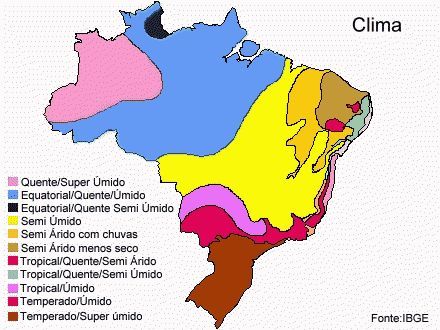Most of the Brazilian territory is found in low latitude areas, between Ecuador and the Tropic of Capricorn. For this reason, hot and humid climates predominate.
With regard to humidity, the climate presents some differences from one area to another, from the super-humid – when the amount of rain is greater than 2,500 millimeters per year, to the semiarid – when the amount of rain is between 300 and 600 millimeters per year.
Climates of Brazil

Types of climates in Brazil
The Brazilian regions present 6 types of climates classified in relation to the “thermal zones” of the Earth, they are:
- Equatorial
- Tropical
- Tropical Semi-Arid
- Altitude Tropical
- Coastal Tropical
- Subtropical
Equatorial Climate
The equatorial climate is found in regions located close to the Equator. It has high temperatures and a large amount of rain during most of the year.
Therefore, the equatorial climate is hot and humid. It predominates throughout the North Region and in part of the Midwest.
The annual average temperature is higher than 25 ºC, and the annual thermal amplitude (difference between the maximum and the minimum temperature) is small. The rainfall regime varies according to the action of the air masses.
In winter, the region can be influenced by cold fronts, due to the movement of air masses coming from the pole.
On these occasions, a phenomenon called coldness occurs, with a sudden drop in temperature that can reach 10 ºC.
Tropical weather
The tropical climate is found in the central region of Brazil, with greater predominance in the Midwest region .
This climate has two well-defined seasons: winter with mild and dry temperatures, and hot and rainy summer .
Average annual temperatures are over 18 ºC and annual thermal amplitude up to 7 ºC. The rains vary from 1,000 to 1,500 mm / year.
As for humidity, the semi-humid climate predominates in the central region of the country.
Semi-arid Tropical Climate
The semi-arid tropical climate is typical of the Northeast Region of Brazil, comprising an area with rains and another where rains are rare and the highest temperatures in the country occur.
It presents average annual temperatures around 27 ºC and thermal amplitude around 5 ºC. The rains, besides being irregular, do not exceed 800 mm / year. It comprises the region of the Drought Polygon.
Altitude Tropical Climate
The tropical climate of altitude predominates in the mountainous areas of the Southeast Region . Because of the higher altitude, they have the lowest temperatures in the entire tropical domain, with an average below 18 ºC.
It also presents an annual thermal amplitude between 7 ºC and 9 ºC, with a rain regime similar to that of the tropical climate. The entry of cold fronts in winter can cause frosts.
Coastal Tropical Climate
The tropical coastal climate predominates in much of the country’s coastline, extending from Rio Grande do Norte to the state of Rio de Janeiro. Influenced by the action of the Atlantic Atlantic air mass, the climate in this region is hot and rainy.
With average annual temperatures between 18 ºC and 26 ºC and rainfall of around 1,500 mm / year. On the northeastern coast, rains are more intense in autumn and winter. On the southeastern coast, they are stronger in the summer.
Subtropical Climate
The subtropical climate occurs in the South Region of the country, below the Tropic of Capricorn, and hence its name Subtropical.
The subtropical climate presents two well-marked seasons: hot summer and severe winter, when frost or snow may occur.
The rains are well distributed throughout the year, between 1,500 mm and 2,000 mm / year. The average annual temperatures are almost always below 18 ºC, with thermal amplitudes between 9 ºC and 13 ºC.

Curiosities
- Manaus, the capital of the state of Amazonas, has an equatorial climate. It rains almost every day in the city, in the late afternoon.
- The city of São Joaquim, in Santa Catarina, with a subtropical climate, is the coldest municipality in the country, with annual averages of 13 ºC. In winter there is a temperature of -9 ºC, with frost and snow precipitation.
- Campos do Jordão is a city in the state of São Paulo, located in the Serra da Mantiqueira, with an altitude of 1.7000 meters. Despite being located in the tropical zone, it has low annual thermal averages, lower than those of areas located in the same latitude.
- The city of Rio de Janeiro is located on the coast, so it has low altitude. Although located in latitudes similar to Campos do Jordão, it has a thermal average much higher than that of the city of São Paulo. It is an example of how altitude influences temperature, or thermal averages.

